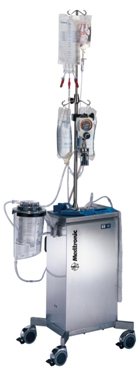临床技术 - The autoLog-Autotransfusion System: An Important Component in Blood Conservation
 Blood Guys International, Inc., Salt Lake City, UT, an advanced clinical service provider, works with hospitals to improve blood management practices in orthopedic procedures. The autoLog® Autotransfusion System, used for blood salvage both intra- and post-operatively, helps them maximize autologous blood return for each patient.
Blood Guys International, Inc., Salt Lake City, UT, an advanced clinical service provider, works with hospitals to improve blood management practices in orthopedic procedures. The autoLog® Autotransfusion System, used for blood salvage both intra- and post-operatively, helps them maximize autologous blood return for each patient.
“We have performed more than 60,000 autotransfusion cases, primarily orthopedic, to maximize autogolous blood return,” said Les Bricker, President, Blood Guys International. “Our experience helps hospitals reduce their dependency on blood bank transfusions, thereby reducing their infection and complication rates while saving them money.”
Pioneering Blood Conservation in Orthopedics
Mr. Bricker was an early supporter of blood conservation in orthopedics beginning in the 1980s. At the time, autotransfusion was used primarily in cardiovascular surgery and trauma cases. He believed that orthopedic patients would also benefit from autotransfusion. “There seemed to be considerable blood loss during orthopedic surgery. For a variety of reasons, no intra- or post-operative blood salvage protocols were practiced. For one thing, blood was very inexpensive and hospitals were not as cost conscious as they are today,” said Bricker. “But when issues of blood-borne pathogens arose, AIDS and hepatitis, for example, they triggered a need for hospitals to be more responsive and to ensure blood safety.”
To convince orthopedic surgeons and hospitals that intra-operative blood salvage could be beneficial to patients, blood loss during total hip and knee replacement procedures was measured. After more than 60,000 cases, Bricker’s team documented that average blood loss in these procedures is about 800 cc’s intra- and post-operatively. In typical blood transfusions, patients receive an average of 1.5 units of packed red blood cells when their starting hematocrit is 38–40%. Since hip and knee replacements are performed overwhelmingly on elderly patients, the impact is significant.
Mr. Bricker also concentrated on educating orthopedic teams on the patient advantages of blood salvage, telling them, among other things, how eliminating the use of banked blood can reduce the chance of clerical errors and minimize the possibility of AIDS and/or hepatitis contamination. “Our success came slowly at first, but it spread to other surgical procedures as hospitals and surgeons realized the patient benefits associated with blood conservation and blood management,” Bricker added.
Today, Blood Guys International provides clinical services to hospitals in multiple states, focusing primarily on orthopedic specialties. “We’ve offered this service for over 23 years and we’re still, to my knowledge, one of the few contract service providers doing this business model,” Bricker said.
“With banked blood running $1,000+ per unit, when all of the direct and indirect costs are figured in, we’re returning about 1.5 units of red packed cells to the patient at a much lower cost. Moreover, our product’s hematocrit and safety aspects are superior,” Bricker continued.
The Role of Medtronic’s autoLog® Autotransfusion System
“In orthopedics, we target a hematocrit of 50–55% since this is the gold standard with banked blood,” said Bricker. “We count on the autoLog® System to give us a hematocrit in that range.”
In Bricker’s opinion, Medtronic is the obvious leader in blood management and blood conservation.